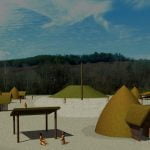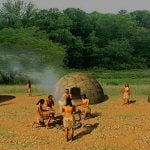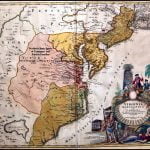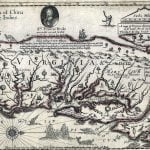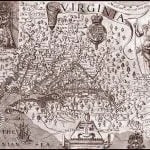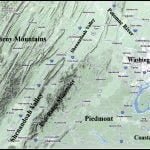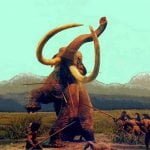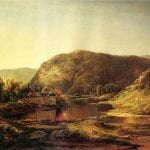The following series of articles, written by Richard Thornton, takes a look at the early Native Americans of the Shenandoah Valley region. Who peopled the area before European contact? How did these Native American’s influence the early events of American history? What archeological evidence remains of these people?
Native American archaeological sites in the Shenandoah Valley are seldom studied. However, historical documents and archaeological evidence show surprising cultural connections in the Shenandoah Valley at various periods to the Ohio Valley, northern Georgia and southern Canada. It appears to have been a place where Native Americans from the north and south generally traded, but sometimes fought. That tradition continued to several major battles in the American Civil War.
Clues to the Identity of the Early Residents
Part one looks at a couple of unusual clues to the identity of early Shenandoah Valley residents.
It is very difficult to go anywhere in the northern part of the valley or along the North Fork of the river and not find history of national or regional importance. This is where George Washington spent much of his early manhood as either a surveyor or commander of the Virginia Militia. Historical markers denoting Indian massacres or Civil War battles can be seen everywhere. There are several rural hamlets that have not changed significantly in appearance since 1860. Several of those villages are composed primarily of houses built before 1820. More remote locations such as around Liberty Furnace on Cedar Creek contain log houses dating from the 1730s and 1740s. Furthermore, the lineage of most, if not all of America’s champion thoroughbred race horses can be traced to ancestors in the Shenandoah Valley.
With such a rich broth of history pertaining to the European occupation being so visible in the Shenandoah Valley, its, almost invisible Native American heritage is not part of the public consciousness. As will be discussed later in this series, the earliest settlers were quite aware of their predecessors, because the ruins of many Native American settlements and mounds were still visible. However, most of the structures created by Native Americans were leveled over two centuries ago, while houses literally stained with the blood of Civil War soldiers are still quite common.
There is a major obstacle to examining the Colonial Era history of western Virginia. No maps were made of the region until all the Native Americans were gone in the mid-1700s. This particularly astonishing since, in contrast, there are maps showing the Native American ethnic groups of the 13th colony, Georgia, as early as 1566 . . . 51 years prior to when Jamestown, VA was founded.
The Shenandoah Valley’s Impact on American History
In part two the history of the Shenandoah Valley after the arrival of Europeans is summarized in order to understand why the Native American history has been largely forgotten.
- The Rickohockens’ Role in Native American Slavery
- Exploration and Settlement of the Shenandoah Valley
The pre-European past of the Shenandoah Valley has long been a tierra incognita for Virginians. However, a map accompanying the published journal of explorer Johann Lederer’s 1671 expedition along the Blue Ridge Mountains, does show the Rickohocken Tribe occupying the same territory in southwest Virginia that after 1718, was labeled “Cherokees.”
Virginia’s historians and anthropologists have assigned the same cultural periods to Native Americans on both sides of the Blue Ridge Mountains. The standard descriptions of these cultural periods usually do not mention the construction of mounds and stone cairns, or the development of large permanent towns.
A closer examination of the archaeological evidence reveals that the indigenous peoples of the Shenandoah Valley apparently were far more similar to their contemporaries in the Allegheny Mountains of West Virginia than to those living east of the Blue Ridge Mountains. However, there were distinct differences from the regions on either side that reflect influence from the Lower Southeast. The unique natural environment of the Valley of Virginia also made possible the existence of large herds of bison, deer and elk. This asset made possible lifestyles for some ethnic groups there, more similar to the Midwestern prairies. Therefore, the following descriptions represent a synthesis of Virginia’s, West Virginia’s, eastern Tennessee’s and northern Georgia’s Native American cultural periods.
The Pre-European Past of the Shenandoah Valley
Part three explores the pre-European past of the Shenandoah Valley.
Much about the Pre-European history of the Shenandoah Valley is still not fully understood by anthropologists and historians. What factual information that is available is typically omitted from the books and web sites readily available for public consumption. In the public’s perspective, several the myths still remain constant. One is that the Shenandoah Valley was uninhabited when Virginia was settled. Official documents describe the inhabitants of the Shenandoah as being primitive hunters and gatherers, who were massacred by a mysterious tribe of “Southern Indians.” In fact, until the late 1600s the Shenandoah Valley was the most densely populated region in the Colony of Virginia. Western Virginia contains the majority of Virginia’s mounds, large indigenous town sites and visible Pre-European ruins.
Eyewitness Accounts
Part four looks at many of the early European eyewitness accounts of the Shenandoah Valley and it’s peoples.
There has been relatively little professional study of Native American archaeological sites in the Shenandoah Valley. The most comprehensive studies occurred in the first decade of the 21st century and the last decade of the 20th century. These recent studies provide physical evidence of the rich Native American heritage in the Shenandoah Valley that was observed by explorers and early settlers.
The Archaeological Evidence
Part five reviews the professional archaeological studies carried out in the Shenandoah Valley in recent years. There have not been many, but they do tend to confirm the rich Native American heritage suggested by early settlers.
Gallery of Photos




